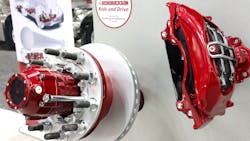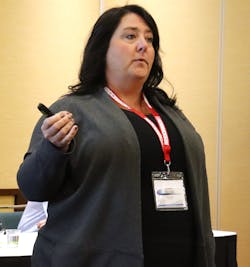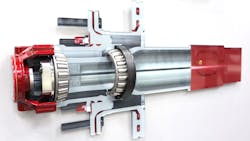Hendrickson launches outboard-mounted ADB rotors for tank trailers
INDIANAPOLIS, Indiana—Hendrickson’s newly launched outboard-mounted rotor option for the Maxx22T trailer air disc brake (ADB) system enhances serviceability and safety by simplifying rotor swaps—and it’s currently available only for tank trailers, reports Adrey Schley, director of wheel ends and brakes for trailer commercial vehicle systems.
“We are launching it exclusively within the tank market to start because you guys were the early adopters,” Schley said during one of three new “Solutions Showcases” held during National Tank Truck Carriers’ 2023 Tank Truck Week at the Indiana Convention Center. “You’re the ones who see the value in air discs, and we have the capacity to handle the tank market now, and then we will spread it across other platforms.”
The new outboard-mounted rotor is a “revolutionary” option for the HXL7 wheel-end package and InTraax LDA (large-diameter axle) suspensions, Schley added, saving bulk fleets money on maintenance, and improving safety by eliminating the need for removing the wheel end to change a rotor, and the opportunity for errors in reassembly.
“There will be a slight upcharge for a premium product, but at the end of the day, you’re getting savings in serviceability and uptime—and overall peace of mind,” she said.
ADB adoption
The outboard-mounted rotor is available today thanks to an improving supply chain after two years of pandemic-induced capacity constraints, Schley asserted. “I’m happy to say, from a Maxx22T standpoint, I can stand here today and tell you that we finally have calipers and rotors in stock, and we can supply orders now,” she said.
With more parts in stock, Schley expects air disc brake adoption to resume an upward trajectory, especially in the tanker market. Pre-COVID-19, she forecasted 20% of all suspensions Hendrickson sold would feature air disc brakes by 2023, but supply constraints limited adoption to 15.3% this year. “I don’t think that’s the demand,” she said. “That’s the capacity of the U.S. market for where we’ve been the last couple of years.”
Tank fleet adoption is significantly higher. Bulk fleets spec’d nearly 40% of their Hendrickson trailer suspensions with air disc brakes in 2018, and that number soared to over 50% in 2022 before falling to 45% this year. “It’ll be interesting to see, now that we’re starting to right size from a supply chain standpoint, what is actual demand?” Schley said. “Are we going to continue to grow about 2% a year, like we were before, or have people settled in on the specs they’re at? I don’t believe 15% is the real demand.”
‘Routine’ maintenance
Hendrickson began supplying air disc brakes for trailers in 2009, but it didn’t hit double-digit adoption until 2013, Schley said; and the growing percentage of fleets who’ve spec’d ADBs since 2018—and now must maintain them—are discovering early advocates for spec’ing air discs over drums forgot to mention the inconvenience of rotor replacements when pitching ADB maintenance benefits, like no greasing points and quicker pad changes.
See also: NTTC launches industry branding campaign
“What are the two parts you’re guaranteed to have to change on an air-disc brake?” Schley asked. “Rotors and pads. If you guys are keeping trailers for 20-something years, you’re not going to have the same rotors at the end of that period. That’s the wear item. It’s going to wear the pads, and it’s going to wear the rotor. That’s a given. But nobody was saying that when we started talking about why you should go with air discs.
Now, Hendrickson is making rotor maintenance routine by moving the rotors from “inboard” to outboard, improving accessibility. “For anybody who’s actually using their brakes, and needs to change their rotors, this is a gamechanger,” Schley said. “It removes the reason for having to take the wheel end apart—which removes risk from your operation.”
Technicians still must remove the caliper and chamber to reach the rotor, but then they only need to loosen 10 nuts to replace a worn or corroded rotor. The HXL7 with outboard-mounted rotor also boasts a longer-lasting seal, Timken tapered roller bearings for durability, redesigned tone ring, and seven-year extended lifespan.
“The entire tone ring now threads [into the rotor] and is retained with two spring pins,” Schley explained. “So, at the end of the day, it’s still going to corrode, but we’ve used [a patented corrosion-resistant tone ring], so they’re not going to chip away; and as it threads, and then when it corrodes, it actually corrodes to itself, and instead of ejecting it … [we keep it] in place, so we don’t have ABS failures—and we can get the rotor to outlive the tone ring.”
Return on enhancement
Carriers could save about $5,000 per trailer over 10 years by reducing parts and labor costs, and eliminating the opportunities for wheel-end reassembly errors inherent with inboard rotors in one scenario Schley identified, while emphasizing maintenance cycles and replacement costs are fleet-specific. “That’s 12 times I’m not going to take the wheel end apart, replace the seal, hope the technician puts in the right amount of lube, sets the end play correctly, puts the hubcap and bolts on, and rebuilds that wheel end correctly,” she maintained.
Schley’s estimate is based on using the HXL7 with outboard-mounted rotor—which also includes TireMaax Pro or Pro-LB—for 10 years on a tanker running in the Northeast. With an inboard-mounted rotor, this fleet could expect to see three years on rotors before the tone ring corrodes, she said. With outboard-mounted rotors, they’d get five—while also deleting 12 hub removals and replacing only eight rotors instead of a dozen.
Additionally, standard repair time (SRT) here is reduced by 24 labor hours per cycle—and the wheel ends remain factory installed.
“You’re never going to disturb the wheel end for those rotor changes,” Schley concluded.
About the Author
Jason McDaniel
Jason McDaniel, based in the Houston TX area, has more than 20 years of experience as an award-winning journalist. He spent 15 writing and editing for daily newspapers, including the Houston Chronicle, and began covering the commercial vehicle industry in 2018. He was named editor of Bulk Transporter and Refrigerated Transporter magazines in July 2020.




